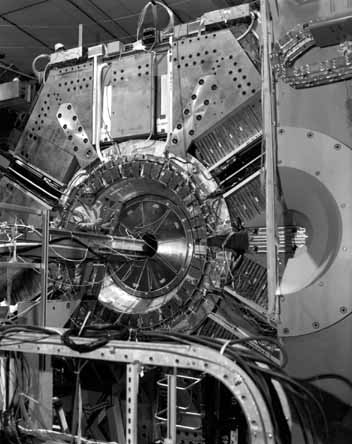 |
|
New Results: Make Headline News by Kurt Riesselmann
Snowmass, ColoradoóWhen more than 1,200 particle physicists gathered for a conference in the Rocky Mountains, research at their home institutions didnít take a break. Two major scientific announcements ñ the observation of CP violation in particle interactions involving B mesons, and the non-observation of the Higgs boson ñ created a series of newspaper articles that informed Snowmass 2001 participants about the latest developments in their field.
Fundamental difference reported
ìAfter 37 years of searching for further examples of CP violation, physicists now know that there are at least two kinds of subatomic particles that exhibit this puzzling phenomenon,î said Princeton physicist Stewart Smith, spokesman for the collaboration. Previously, physicists only had observed CP violation in processes involving K mesons, composite particles containing a strange instead of a bottom quark. Scientists believe that the violation of charge and parity (CP) symmetry in subatomic processes holds the key to explaining why the Universe consists entirely of matter while antimatter disappeared shortly after the Big Bang.
The SLAC announcement is the latest highlight in a decade-long success story that focused on the determination of sine-2-beta, a measure for the amount of CP violation present in the B system. Initial measurements by the CDF collaboration at Fermilab in 1999 seemed to favor a non-zero value, but the results were far from being conclusive. Physicists eagerly waited for special B Factories, under construction in California and Japan, to start operations.
Although the new result agrees with the current theoretical framework, called the standard model of particle interactions, the present theory is not sufficient to explain the great abundance of matter in our universe. Physicists are eager to find additional CP-violating processes beyond the standard model.
ìWe are poised for further discoveries that should open up new directions for particle physics,î Smith said.
Higgs still missing
The media frenzy continued in November when scientists pleaded with Luciano Maiani, director general of CERN, to continue their experiments. Maiani and other decision makers, however, found the Higgs results to be far from conclusive and decided to pursue the demolition of the LEP accelerator to advance the construction of the new LHC accelerator.
Lacking new data, scientists at CERN turned to a careful re-analysis of last yearís data that possibly contained tracks caused by the Higgs boson. On July 10 they presented their combined preliminary results. Though the data are still tantalizing and may contain some true Higgs signals, the evidence got weaker from a statistical point of view. Chris Tully, a Princeton physicist who was a strong proponent of extra time for the LEP experiments, conceded in a New York Times interview that ìfor the laboratory, Maiani made the best decision.î
Despite the revision of the CERN results, scientists still expect the Higgs particle to be ìjust around the corner.î A wealth of experimental data indicates that the Higgs boson, though too heavy to be produced by the LEP accelerator, could be within reach of Fermilabís upgraded Tevatron accelerator. Collecting enough data to see it will take years, however. Fermilab scientists could run out of time when the LHC accelerator (seven times more powerful than the Tevatron) begins operation in 2006.
Meanwhile, the physicists at Snowmass continued debating the future of the field. Physics doesnít stop, even if you are in the Rocky Mountains. |
| last modified 6/4/2001 by C. Hebert email Fermilab |
FRLsDFx9eyfrPXgV
 The BaBar and Belle collaborations, experimental groups using the two new B facilities, presented their first data in July 2000. The SLAC group recorded more than 32 million pairs of B mesons. They reported a value of sine-2-beta equal to 0.59 +/- 0.14, substantially different from zero.
The BaBar and Belle collaborations, experimental groups using the two new B facilities, presented their first data in July 2000. The SLAC group recorded more than 32 million pairs of B mesons. They reported a value of sine-2-beta equal to 0.59 +/- 0.14, substantially different from zero.